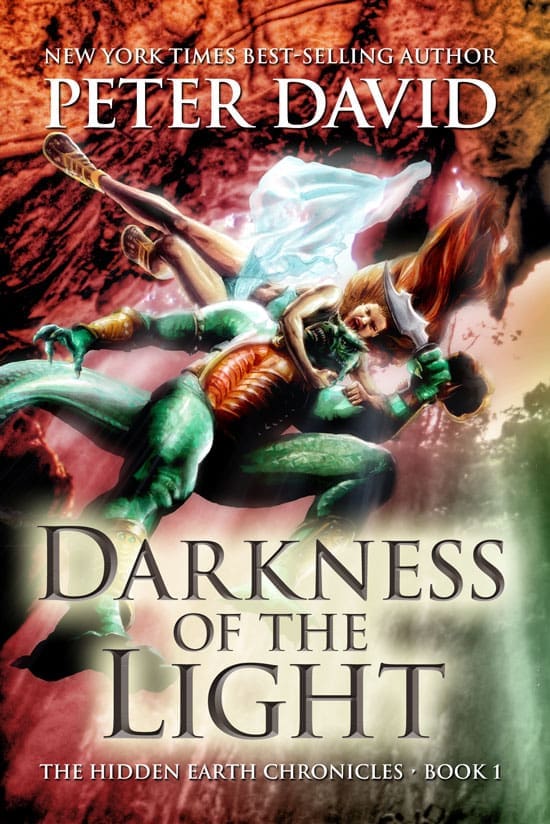I’ve noticed fans lately commenting on the fact that Marvel is routinely renumbering and relaunching series. Some fans see this as a relentless marketing gimmick while others seem to understand the need for doing so: to attract new readers.
If it were up to me–if I were running Marvel–I would do away with numbering entirely.
There’s no point to it anymore.
It’s not like in the days where I was first buying comics, where I could cheerfully buy “Action Comics” or “Detective Comics” and not feel compelled to obtain the previous several hundred issues worth of books. Nowadays the longer a book goes, the more the numbering serves as a disincentive. If a book gets up even to the twenties or thirties, new fans won’t be bothered to pick it up because they don’t want to invest in the considerable capital required to purchase the previous books; and no one wants to come into a story that is already underway, no matter how much Marvel might be putting summaries on the title page. So the numbering discourages new readers from coming aboard while simultaneously you’ll lose readers through attrition, if nothing else.
As far as I’m concerned, numbering has outlived its usefulness. When was the last time anyone gave a dámņ which issue number “Time” or “Entertainment Weekly” was up to? I would simply put the month and year on the cover for reference and be done with it. This is the July 2016 issue of “Spider-Man 2099.” What more do you need to put it in the correct order in your longbox?
If Marvel just does away with numbering, yes, they’ll lose the advantage of relaunching with a new number one. But the more number ones they produce, the more they make people tired of the obvious promotion. On the upside, they’ll stop losing potential new readers, so to my mind, that’s a wash.
PAD





I agree! I actually like the way the Hellboy/BPRD books have been done for a while now, as a series of mini series.
I always kinda wished they’d try and do “seasons” like on TV. Where it’s just 12 issues or so per season, and then they swap creative teams, start a new arc etc.
The seasons model makes a lot of sense these days, too.
Hypothetical Question: When an event happens along the lines of Superior Spider-Man, where the title character is replaced, would that be SUPERIOR SPIDER-MAN: SEASON ONE or AMAZING SPIDER-MAN: SEASON FIFTY?
Because I feel like you’d want to give a sense of the character’s unbroken history, but then you’ve got storylines where the interruption is the point. (Personally, I lean toward unbroken…)
I put waaaaay too much thought into these things…
In a way, that’s what Marvel kinda does sometimes. Like with the late Fantastic Four, where after Hickman they relaunched with Fraction and when he was done, they relaunched again, with Robinson, just like it was a new season. But yeah, it’s not as clear, and if done with more grace and order, I think it would be a pretty cool format to try.
Isn’t that essentially what happens now, though? That’s what happens every time a series is relaunched, basically.
Sure, but with ‘seasons’ you’d arguably get a better sense of where a ‘volume’ falls in the character’s history, right there on the cover.
Interesting concept, though, say you have Spider-Man 2099 and you have 100 issues, just with the date, you still have that new reader coming along and seeing 100 previous issues. Plus, you can just launch the title under a new name The Amazing Spider-Man 2099, the number on the cover really doesn’t matter at that point. Just a thought. I like both long series and relaunches, so I’m an easy customer
I like the idea.
The old Gold Key comics didn’t always have the issue number on the cover. They had it inside in that little section on the front page. Marvel could always just put it there for those that might be outraged and then just the date on the cover
Totally agreed!
Interesting! I’ve never thought of it from that angle.
That would also make shorthand references to issues much easier. If you try to bring up, say, Deadpool #4 in a conversation, the question becomes, “Which Deadpool #4?”
I guess they could still do anniversary issues, based on dates instead of numbers.
I’m all for it. “Simplify, simplify, simplify,” as Thoreau says.
I’d like to see them retain the number in the index box inside the book, to help collectors with ease of filing. But while I like your idea, to tell you the truth I do find the cover numbers helpful. I’m one of those people who doesn’t order via Previews, and I also don’t always read my comics as soon as I buy them. So if I make a mistake in my weekly order and go to file the comics in my to-read box, it’s helpful to see right on the cover if I’ve inadvertently skipped a book.
The one advantage of numbering is that it lets you keep the order when issues get delayed. If you have the August and October issues in hand, you don’t know whether you’re missing one or if there was a delay causing the September issue to get bumped to October.
Hmmm, good point.
As a Serials Librarian who has to deal with this sort of problem all the time, I concur whole-heartedly that numbering still serves a vital purpose. Trying to determine if the gap in time is because nothing was published or because the issue got lost in the system leads to a large amount of frustration. And don’t even get me started on publications that are years behind schedule and are just now putting out their 2012 issues . . .
The big difference as I see it is that “Time” and “Entertainment Weekly” don’t have continuing stories; each issue is a stand-alone (except if they have a letters page regarding past issues). Comics don’t work that way.
If anything, In “the days where I was first buying comics,” there wasn’t really a need for numbering. Archie, Harvey, DC through the early 70s, etc. almost never had stories that continued from issue to issue. Those are more comparable to newsstand magazines than today’s comics are.
Well, there are a few things going on here.
First, the original convention was created about postage. It was cheaper to ship ongoing issues than to start shipping a new one (that’s why Marvel changed titles so many times in the 1940s and the lean years of the 1960s: which issue number was claimed when a title changed was their argument for NOT paying extra to ship the books.)
But the convention was also heavily influenced by the speculation market, when the 1990s titles started over and an explosion of collecting activity focused on lower numbers over higher numbers.
The argument against numbering is precisely what David laid out: this new transmedia environment with an expanding readership is ill-served by an archaic convention that doesn’t even serve the first few purposes it was created to serve while confusing new entrants to the reading community.
But there are multiple reading audiences in play, which complicates considering a change.
One of the arguments in favor of keeping the convention is about continuity. For those readers who care about the order of stories, going to a month-date-only system adds confusion. When Bendis was writing Avengers:Disassembled, was Cap’s book reacting to those events or House of M or the Captain America and the Falcon miniseries? The months rarely match up well, because creators are on different schedules, and some stories pace themselves differently than others. I can remember reading Civil War and Captain America at the same time and it taking months for Brubaker to get his story arc complete enough to incorporate what was happening over in Civil War. Same with New Avengers.
The numbering helps, because if I’m assembling a chronology, saying “Read Civil War November 2006 and then read Punisher War Journal February 2007 and then read Amazing Spider-Man December 2006 …” That would be an actual continuity arc. Chronological universe readers understand the dating system is perpetually off, so the numbering system is what helps them organize. But then, they are reading very differently than people dropping in just for Brubaker’s run on Captain America or Peter David’s run on She-Hulk.
And that’s not even touching the mess around collecting. When a one-off event issue called “Captain America Comics” (the anniversary special) appears the same month as Captain America v5 #49, and Captain America Theater of War: Brothers in Arms … the dates work against making sense of all that if one is not VERY familiar with how the titles intersect or diverge.
I’m not saying the convention shouldn’t be changed, I’m just pointing out that conventions tend to encourage or privilege a particular kind of reading or collecting, and there are several kinds of reading and collecting activities going on with these materials right now. So a change should be seen as increasing accessibility for a particular kind of reading for a particular kind of consumer.
If Marvel were smart, they would create a new convention, maybe built around a master trade numbering system (trades are already generally collected around story arcs). So Brubaker’s Captain America v5 #2 might be the second chapter in a 12-issue trade (Captain America Trade #2005) and the issue reflected that (Captain America 2005.1.2, where it was year, arc #, chapter #). In other words, take this serial monster and move it closer to a scheduled book format as the prime organizing element. Of course that would entail assuming every book would be a trade, which is not true of unpopular books. (So let’s be real for second: the issue format still does allow a publisher to experiment and change direction quickly when something doesn’t sell. And that function might need to be considered in a more coherent system).
Of course, that would only work if Marvel would either reduce the amount of crossover events, or plan them better to fit into their system, or be better at assuring all creators hit deadline and that creators talk more. And that means changing the text, and probably spending a lot more resources in an already tight production model.
(I can already see many problems, the above won’t work, my main point is that how the preferred target audience reads should be the starting point with considerations for all the different reading agendas, not what makes sense for only one reading group).
The current system is confusing, but offers a polysemic (multiple forms of entry and engagement) advantage over a more firm system. That has served the industry well in the past, but this new environment and the expanding consumer bas (with an expanding breadth of use) means that more new readers are underserved by the older convention.
I really hope someone is thinking about this. Or consulting someone in library or information science for thoughts about how to organize content to make it more accessible.
Peter: But the more number ones they produce, the more they make people tired of the obvious promotion.”
Yeah, but that’s only old readers, and Marvel doesn’t care about them.
Me, I wish they would return to legacy numbering for old fans, and if they want to attract new readers, de-emphasize the legacy numbering by emphasizing which part in the story arc the current issue is on the cover.
I also don’t like the fact that they no longer include volume numbers or the month in the date in the indicia inside the front cover.
I agree about the month being left off of the indica! For that matter, it has become a bit chase just to find the indica – is it in the front of back of the book…is it there at all?
Regarding the volume, I suspect that it has gotten too confusing, particularly with a series that interrupts its sequence of numbering with new numbers and volume number, only to revert back to the old numbers. Yeah, I’m looking at you, Amazing Spider-man, Detective, and Action Comics!
I love how DC brought back the original numbering for Action Comics and Detective Comics. There’s no pressure to buy all 950 previous issues, but it is a neat way to honor the past and say this book has been around for 75 years. I wish DC would have brought back the original numbering for all their titles.
I have a friend who’s Swedish, and apparently in Sweden comics are numbered 1-12, for each month of the year, and then start over again in January (at least this was the way it was back in the 80’s, for their reprints of American comics; one can see how this might be problematic if a new comic started in the middle of the year).
I’d be fine with just putting the month and year on a comic, but they’d probably still need to include volume and number somewhere on the inside just for record keeping purposes (I never quite understood what “volume” was supposed to indicate when it was included in the publishing info they used to print at the bottom of the first page).
This would definitely work in my mind. The only question I have would be : how would this work for bi-weekly books, like DC Rebirth titles? July 1, 2016/July 15, 2016?
Exactly.
PAD
DC has had bi-weekly books before that have be dated something like “E. June” and “L. June” (for example). The “E” and “L” standing for “early” and “late” respectively.
Maybe going with simple volume and issue numbers on the cover is best, with any applicable legacy numbering being in a lower corner or on the indicia.
That volume/issue system would not have to be tied to the calendar year, so if a 12-issue series happens to start in January, but various delays means issue 12 doesn’t come out until April of the following year, it would still be labeled as volume 1, issue 12, even though it was printed the following year.
And if someone needed to know when this hypothetical issue 12 came out, the year would be on the indicia. But for everyday cataloging purposes and making sure you hadn’t skipped an issue, I think volume/issue (with or without legacy numbering; my preference is with) works best.
And since a volume wouldn’t necessarily follow the calendar year (that’d be up to a company’s particular preferences), there’d be no problem/concern about a series starting in, say, July.
At present, the only title I’m reading is Buffy, which does “seasons.” The most recent issue is season 10, #28. when season 10 ends, they’ll start over with #1 for season 11. Those season-long numbering systems effectively incorporate the volume/issue idea I’m suggesting. How the “volume” is defined would be up to the individual company or creative team, whichever. PAD, for example, becomes the new writer of Aunt May: Ninja Assassin, with the book taking a whole new direction. Marvel might “renumber” it as volume 2 and keep it at volume 2 until PAD leaves years later or until he says he’s taking the book in another direction and that a new volume number would be applicable.
To use an example from an actual comic, had this volume/issue numbering system been in place in the 90s, one could argue that Incredible Hulk #377, the beginning of the “merged Hulk” era, could have been a new “volume.”
My point is that however a volume is defined by a particular company, as long as the issue numbers are in sequential order, there shouldn’t be a problem.
Any storylines that cross from one book to another could have a simple number system on the cover, the way the “Super” books did in the 90s. I’m sure that was useful for people who only read those books. They could file them all together in the same box, in story order, ignoring the issue numbers of the various titles.
This whole volume/issue idea would also work when and if comics in the U.S. are published from the onset in what we’d consider trade format (or similar to it), rather than in 22 page “magazines.” For example, each “issue” might be 75 pages and come out every three months.
Rick.
DC Comics used to include the volume number in their indicia. The volume number changed every calendar year, so the first issue of the new year had a new volume number.
I don’t mind a series being numbered from the start to the present. Renumbering with a new #1 feels fake; to quote MONTY PYTON AND THE HOLY GRAIL “You’re not fooling anyone, you know.” I don’t think anyone will see high issue #s and pass out of some obligation to get the whole series to understand it. A bigger concern for most readers would be starting to read a book in the middle of a complex or convoluted storyline. (And they’re not always named: I love KNIGHTS OF THE DINNER TABLE, but anyone starting with the current issue will be mostly lost, as it has everything from Bob’s issues with Sheila to Brian’s horrible actions to the bad blood between the Knights and the Hard Eight Hacksmiths.)
Wasn’t enumeration one of the requirements for a periodical to get Second Class mailing privileges for subscription copies?
If that’s true, well, who in the last forty years has gotten their comics individually delivered via the postal service?
If numbering was for that, then the only reason to continue it is tradition.
Or so it seems to me. YMMV and all that.
I wish your website, Peter (Glenn), allowed for an extra line space as well as a new line when ‘Enter’ is pressed.
Well, I work at the Post Office and I’ve seen many regular comic books being delivered via the Postal Service.
When I worked in the “flats” section (which handles magazines), I saw dozens of comics going through.
Recently, in fact, I manually had to case three different Archie digest volumes going to three different addresses in three different cities.
Obviously, SOME people still subscribe and get their comics through the Postal Service.
JosephW, thank you for the correction. Facts are always better than assumptions.
Wouldn’t universe numbering (and maybe reboot numbering) on the cover allow for easier following of continuity than issue numbering?
But Time and Entertainment Weekly aren’t telling stories in a serialized format. Perhaps if they simply show a number in the context of the story arc. So, “Amazing Spider-man – Aunt May’s Revenge #4 – July 2016”. Maybe use “Vol. 3, Part 4 – July 2016” in the absence of a titled story arc.
I suggested something similar a while back: Make each story arc a miniseries, and number within the mini. As long as people know this mini is (probably) going to be followed by another one, you get rid of the “eh, this is just a side thing that doesn’t *matter*” problem.
To paraphrase
When every issue is a number one, no issue is a number one
Being from the UK, where comics are published weekly and very rapidly get in to the thousands, issue numbers, while existing, are pretty meaningless. All they serve is to let me know that THIS issue, is not THAT issue and as a quick method of ordering the story. The dates are still there but the numbering system is quicker.
On the whole, individual numbers are not that important in the UK
I kind of like what DC did when they relaunched Adventure comics a few years back. They had dual numbering – both the restarted numbering (from number 0), and continuing the original numbering (from 4 hundred and something).
Marvel did this on a few titles when they went through their phase of relaunching everything, then deciding as a bunch of books were nearing milestone numbers that they needed to honor the old numbering. So, several titles had both the new volume number, and next to that was the numbering as if they had never relaunched.
I recall Avengers being one of the titles where they did this, just so they could have #500. And then a few issues later they relaunched it again for a new #1.
And yeah, to me it’s always felt like a gimmick.
My least favorite thing about frequent renumbering is that I now have to keep a spreadsheet for reading order when I fall behind. Even if you’re just reading Captain America, not reading for a couple years means you might be dealing with three or four different series. Casual readers are left behind.
It also annoys me when a new series begins, yet the paperback collection is numbered as a continuation of the previous series (as with Ms. Marvel and Hawkeye). Why bother relaunching if it’s a continuation and not a genuine fresh start?
You have a point there. A casual reader or potential customer would find this month’s comics completely impenetrable.
Which issue do I read first? Which of these is the character I saw in the film last month? Why are there three comics with the same character and how do they relate to the three, differently named comics that were out a few months ago?
I really cannot see how this all serves to GROW a market. It simply diminishes it in the long run.
I recently did an article on this for Diamond Bookshelf http://www.diamondbookshelf.com/Home/1/1/20/181?articleID=177023
When was the last time a comic book attracted a new reader? Aren’t they all juggled by the same tiny slice of the public? Is that REALLY the issue of attracting “new readers”, or is it that contemporary comics are completely impenetrable to all except the most hardcore devotees, who aren’t even completely happy with the product but buy out a sense of duty?
Doing something like that requires a consistency of publication frequency and a storytelling approach that I don’t Marvel is particularly big on anymore. More and more books are written like “serialized graphic novels”, and seem to assume you’ll go back for “chapter 1” if you missed it (presumably via tpb).
Or to be nicer about it, what happens if you pick up the random issue, like what you see, and want more? How do you figure out what to get? Numbering just makes everything simpler. Well, it should, anyway.
I think all this re-numbering just creates confusion and damages long term sales. If I hear good things about Jason Aaron’s Thor and want to start from the beginning, which of the three Thor #1s he’s done do I start with? (And how annoying is it to start with a #1 and find out there are actually 33-42 issues (if you count Thors and Tenth World) ahead of it?)
I’m getting used to the notion that the good old days of a series starting with #1 and then going until it ends or is cancelled are behind us. But could they at least tie the volumes to writer shifts or something? (Or at least clean up all of their open messes before starting over?)
A few thoughts here:
First off, agreed we need the dates back on the cover. This is especially important for buying back issues. It can be a pain when you have to look at things like cover price, cover structure for a period in time etc to determine if, say a comic issue #4 is 2015 to 2016, or for that matter, #4 that came out early 2015 vs #4 that came out late 2015.
As a kid I liked #1s but I also liked seeing titles with big numbers; I tended to see the lower numbers as for the interesting but just starting out series (or if an older back issue, a short lived title) and the higher numbers for titles that had proven staying power. So the numbering actually put me in a different kind of mood. Sometimes I wanted to read about the big guns, other titles i wanted to read about the hidden corners. As an adult, I prefer seeing the higher numbers for veteran titles but also don’t mind the dual number idea, letting people have their #1s and their higher numbers.
One thing that is adding some additional confusion is that when books renumber, they’re also starting to rename. So you might have [Hero’s Code Name] followed by [Hero’s Real Name: Hero’s Code Name] followed by the Uncanny/Astonishing [Code Name] followed by the All-New [Code Name] followed by the All-New All-Different [Code Name]. Plus Marvel has those Point One’s, so you could buy issues 20 and 21 and realize too late that 21 followed 20.1 which you don’t have. Frequent name changes to a title and gimmicks like .1 (or 1/2 or 0 etc) where you can buy consecutive issue numbers and still miss hidden numbers can drive away old and new readers alike.
So my position is best summarized as, I like the big numbers, but I’m fine with any system where if I like a title I can find all the issues, including back issues if so desired. Keep it simple and don’t force your readers to have to do a lot of research to keep up with or catch up on a series they like.